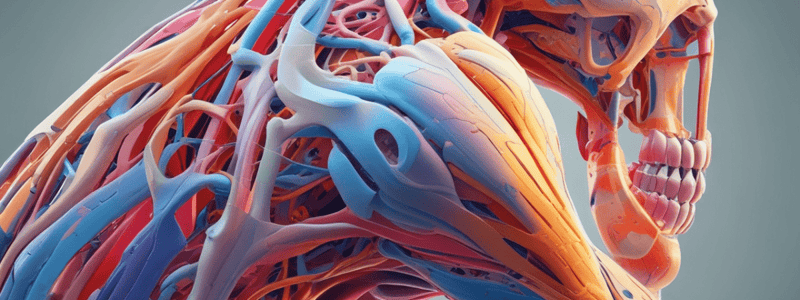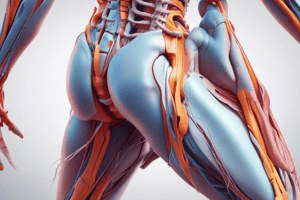Podcast
Questions and Answers
Kinesiology of the Musculoskeletal System is divided into 3 major sections in the textbook.
Kinesiology of the Musculoskeletal System is divided into 3 major sections in the textbook.
False (B)
Section II of the textbook focuses on the lower extremity, from the hip to the foot.
Section II of the textbook focuses on the lower extremity, from the hip to the foot.
False (B)
In the 1st semester, students focus on Section I and III of Kinesiology of the Musculoskeletal System.
In the 1st semester, students focus on Section I and III of Kinesiology of the Musculoskeletal System.
True (A)
Section III of the textbook covers the kinesiology of the axial skeleton, including the head, trunk, and spine.
Section III of the textbook covers the kinesiology of the axial skeleton, including the head, trunk, and spine.
The study of kinesiology involves examining only the anatomy and physiology of body movement.
The study of kinesiology involves examining only the anatomy and physiology of body movement.
The special chapter on mastication and ventilation is included in Section IV of the textbook.
The special chapter on mastication and ventilation is included in Section IV of the textbook.
First Class Levers have the Axis of Rotation between two opposing levers.
First Class Levers have the Axis of Rotation between two opposing levers.
Second Class Levers are the most common musculoskeletal lever.
Second Class Levers are the most common musculoskeletal lever.
Third Class Levers have the Axis of Rotation at one end of a bone.
Third Class Levers have the Axis of Rotation at one end of a bone.
First Class Levers have Mechanical Advantage (MA) equal to 1.
First Class Levers have Mechanical Advantage (MA) equal to 1.
Second Class Levers have the muscle possessing greater leverage than the External Force.
Second Class Levers have the muscle possessing greater leverage than the External Force.
Third Class Levers are considered the most efficient type of musculoskeletal lever.
Third Class Levers are considered the most efficient type of musculoskeletal lever.
In the open packed position of a joint, ligaments and joint capsule are most taut.
In the open packed position of a joint, ligaments and joint capsule are most taut.
Kinetics describes the motion of a body without regard to the forces acting on it.
Kinetics describes the motion of a body without regard to the forces acting on it.
The quantity of force (F) can be measured by multiplying mass (m) by velocity (v).
The quantity of force (F) can be measured by multiplying mass (m) by velocity (v).
Musculoskeletal forces are always referred to as loads that stabilize the body.
Musculoskeletal forces are always referred to as loads that stabilize the body.
Kinesiology is the branch of mechanics that focuses on describing the motion of a body.
Kinesiology is the branch of mechanics that focuses on describing the motion of a body.
An increase in force applied to a body will always result in an increase in acceleration.
An increase in force applied to a body will always result in an increase in acceleration.
Is the stretch immediately before the concentric contraction essential for producing greater torque during the concentric contraction?
Is the stretch immediately before the concentric contraction essential for producing greater torque during the concentric contraction?
In isokinetic muscle contraction, is the angular velocity of the bony component variable?
In isokinetic muscle contraction, is the angular velocity of the bony component variable?
Is isoinertial muscle action characterized by acting against a variable load or resistance?
Is isoinertial muscle action characterized by acting against a variable load or resistance?
Do alpha motor neurons play a role in exciting muscles through impulses generated from outside the nervous system?
Do alpha motor neurons play a role in exciting muscles through impulses generated from outside the nervous system?
Are the cell bodies of alpha motor neurons located in the posterior horn of the spinal cord?
Are the cell bodies of alpha motor neurons located in the posterior horn of the spinal cord?
Is a motor unit composed of a single alpha motor neuron and its network of innervated muscle fibers?
Is a motor unit composed of a single alpha motor neuron and its network of innervated muscle fibers?
Active insufficiency occurs when the muscle is excessively lengthened.
Active insufficiency occurs when the muscle is excessively lengthened.
Sarcomere length tends to deviate significantly from the optimal length during joint movements.
Sarcomere length tends to deviate significantly from the optimal length during joint movements.
Mass is a measure of the amount of force acting on an object.
Mass is a measure of the amount of force acting on an object.
Weight is the measure of the amount of matter within an object.
Weight is the measure of the amount of matter within an object.
Under the influence of earth’s gravitational pull, 1 kilogram mass weighs 9.8 kg*m/sec^2.
Under the influence of earth’s gravitational pull, 1 kilogram mass weighs 9.8 kg*m/sec^2.
The book 'Kinesiology of the Musculoskeletal System' was published in 2005.
The book 'Kinesiology of the Musculoskeletal System' was published in 2005.
'Joint Structure and Function: A Comprehensive Analysis' was published by Elsevier.
'Joint Structure and Function: A Comprehensive Analysis' was published by Elsevier.
Mass and weight are interchangeable terms with the same meaning.
Mass and weight are interchangeable terms with the same meaning.
The influence of muscle activation in active insufficiency is beneficial for muscle performance.
The influence of muscle activation in active insufficiency is beneficial for muscle performance.
Gravity has no effect on an object's weight.
Gravity has no effect on an object's weight.




